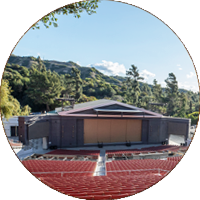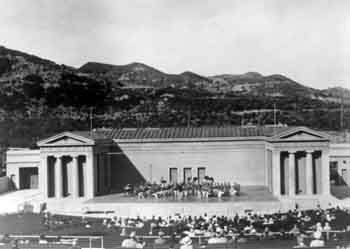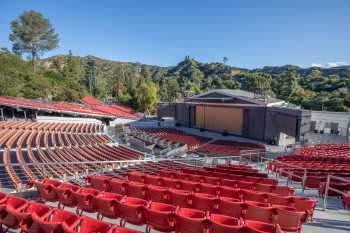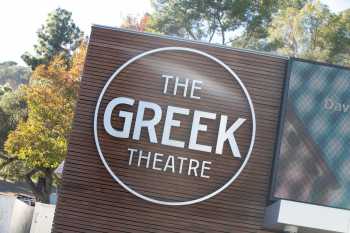

<< Go Back up to Region ‘Los Angeles: Greater Metropolitan Area’
| Follow Mike Hume’s Historic Theatre Photography: |  |
 |

Architect: S. Tilden Norton
First Opened: 25th September 1930 (95 years ago)
Website: www.lagreektheatre.com 
Telephone: (844) 524-7335 
Address: 2700 North Vermont Avenue, Los Angeles, CA 90027 
The Greek Theatre is an outdoor theatre located in Los Angeles’ Griffith Park. Modeled after a Greek temple, it was designed by Los Angeles based architect Samuel T. Norton and associated architects. More than 90 years after its opening, the Greek Theatre remains a popular outdoor live entertainment venue in the center of Los Angeles.

 Detailed Information
Detailed InformationThe Greek Theatre is located in Griffith Park, named for Griffith J. Griffith, who donated over 3,000 acres to the City of Los Angeles for the creation of a public park in 1896.

Griffith stated that the land was to be used as a park, “for the purposes of recreation, health and pleasure, for the use and benefit of the inhabitants of the said City of Los Angeles forever”. Griffith also said that the park must be named Griffith Park.
Griffith died in 1919 and left a trust that contained $1 million for the construction of an observatory and a Greek style theatre. Of the $1 million to build the Observatory and the Greek Theatre, only $100,000 was earmarked for the theatre.
After extensive analysis, a canyon site was chosen for the theatre because of its good acoustics. Allegedly, singer Ellen Beach Yaw was contracted to yodel into various canyons in the park to help select the site. The cornerstone was laid in 1928 and the construction cost was $208,000, $100,000 of which came from Griffith’s original gift.
The theatre originally was much more like a Greek Temple, with an open-air stage and Greek style columns on the sides of the stage in addition to three doors in the rear stage wall (still extant but hardly ever used or seen).

The building was dedicated on 25th September 1930. The dedication was opened by Ellen Beach Yaw followed by Chief Yowlache leading traditional Native American dancing, then Norma Gould with a Greek style dance troupe. The evening drew to a conclusion with a traditional Greek play.
Despite the success of the dedication, the theatre sat mostly empty for about a year until the first major show on 26th June 1931.
The theatre underwent a number of changes in the 1950s, largely with a $100,000 bond issued in 1957 by the City for a revamp of the theatre. Work was completed in 1960 and saw the open-air stage roofed over, and counterweight flying system installed, plus the addition of various external buildings such as the box office. The changes to the stage are reversible, should the need ever arise.

Between 1975 and 2015, the theatre was managed by the Nederlander Organization, which further improved it and began a regular rotation of contemporary and classical productions and concerts.
In the 1980s, additional wings of seats were added boosting the capacity from 4,000 to 5,900 – about the same as Radio City Music Hall.
The theatre underwent an earthquake retrofit in 1995, and around 10 years later the façade was renovated in celebration of the theatre’s 75th anniversary.
In the mid 2010s the City of Los Angeles stopped leasing the theatre to external parties to manage, preferring to manage the venue itself. Architect firm Page & Turnbull  were brought in to advise on historic restoration, and many original elements were recovered and restored.
were brought in to advise on historic restoration, and many original elements were recovered and restored.
The Greek Theatre continues to be a popular live events venue in Los Angeles.
 Listed/Landmark Building Status
Listed/Landmark Building Status Further Reading
Further Reading about the Greek Theatre.
about the Greek Theatre. on Wikipedia.
on Wikipedia. official website.
official website. Technical Information
Technical Information Photos of the Greek Theatre
Photos of the Greek TheatrePhotographs copyright © 2002-2025 Mike Hume / Historic Theatre Photos unless otherwise noted.
Text copyright © 2017-2025 Mike Hume / Historic Theatre Photos.
For photograph licensing and/or re-use contact us here  . See our Sharing Guidelines here
. See our Sharing Guidelines here  .
.
| Follow Mike Hume’s Historic Theatre Photography: |  |
 |